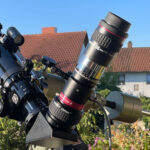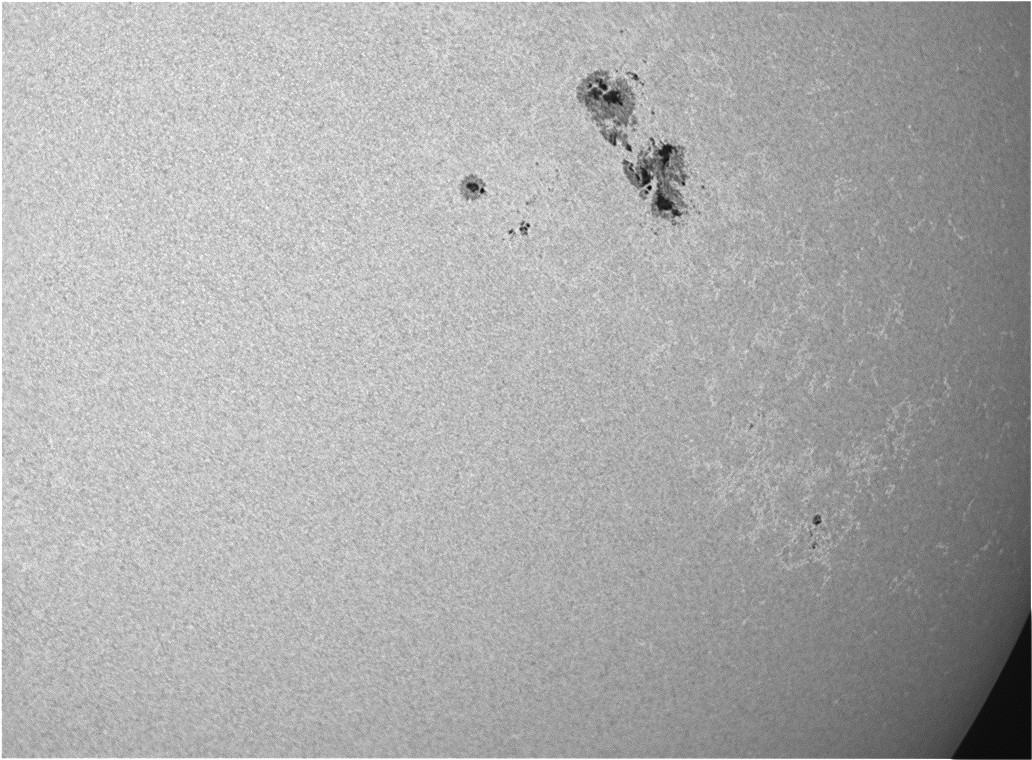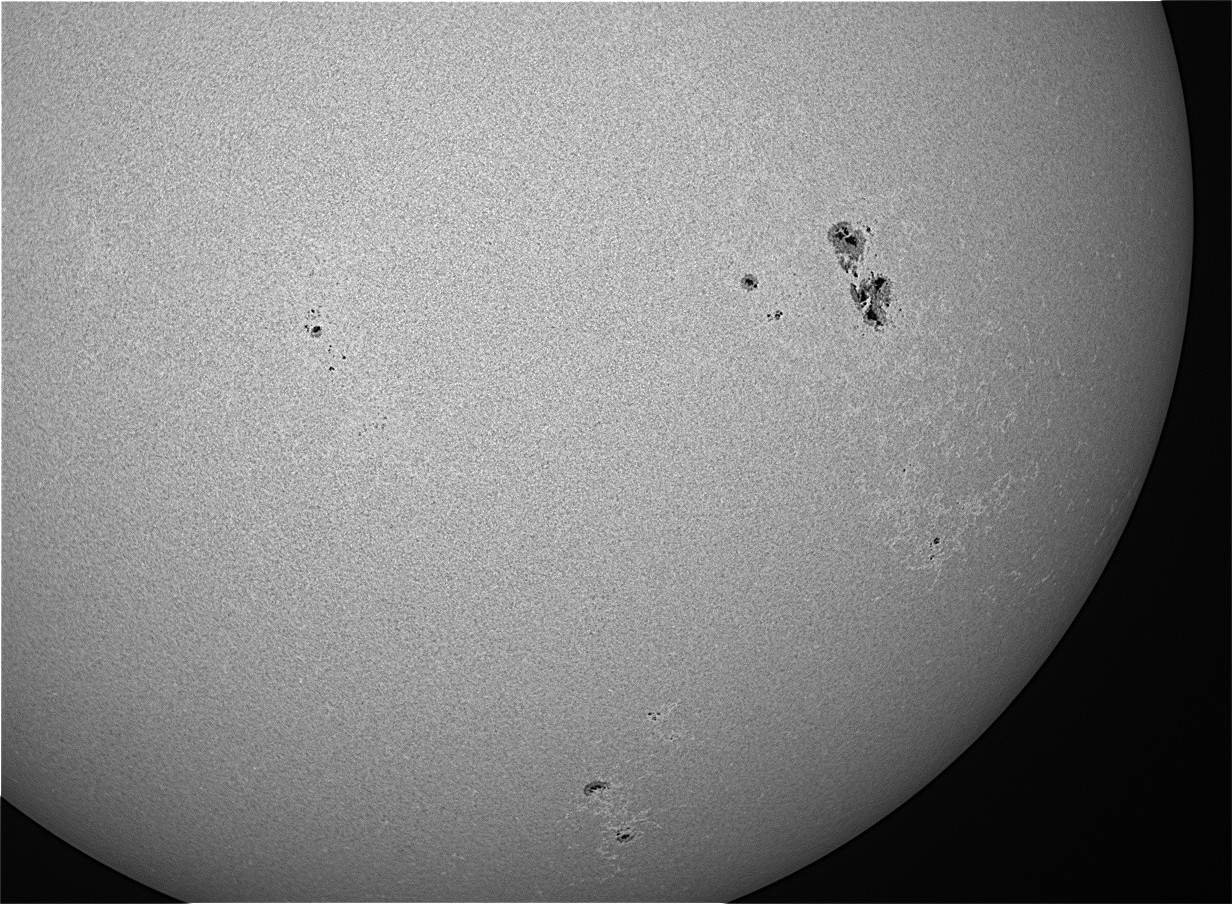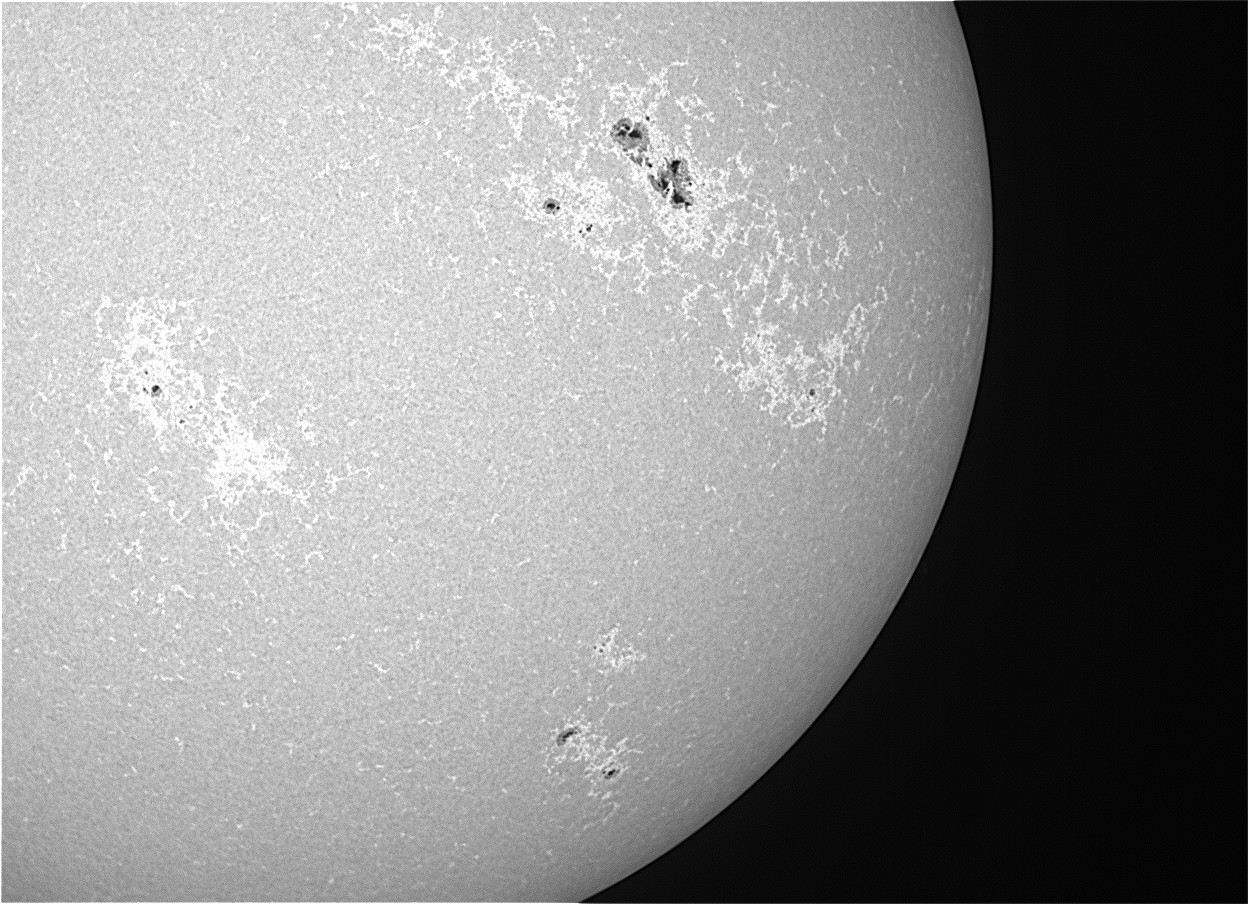In the spring of 2022, I had the chance to give my opinion on a couple of prototypes of a possible successor to the K-Line filter. The calcium line (CaK) was the only part of the solar spectrum that I had not yet covered with my solar setup. This absorption line is indeed somewhat exotic, and the required filters are not very widely distributed.

The Sun in white light: Here is a test of the: Baader Solar Continuum Filter revisited – now with FWHM 7.5nm
The familiar sight of the white-light (continuum) Sun through a Herschel prism or astrosolar film is probably well-known to everyone who has ever tried solar observation. White light is the cheapest and easiest part of observing the sun - in the simplest case, this can even be done by projection as with the . I have used this part of solar observation for decades, not only through my work at the Observatory in Heilbronn. Especially with monochrome cameras and the improved Baader 7.5nm Solar Continuum Filter (540nm) (various versions available) , which has been available since autumn 2022, it is possible to get a lot more sharpness and detail when observing the surface of the Sun (the photosphere) in white light, even with the actually modest 80mm aperture that I usually use.

Review: The H-alpha-sun with the Baader SunDancer II H-Alpha Filter
The purchase of the Baader SunDancer II H-alpha Filter (#1363056 , € 3545,-) (and working as a freelancer in homeoffice with free working hours) gave my solar observations another boost. This 0.6Å-filter shows the Sun's chromosphere, so I can see the Sun's "upper atmosphere" – especially the prominences.
And a Calcium-filter? It unveils the border zone – the region between photosphere and chromosphere. Here we can see e.g. the chromospheric network which precedes the formation of sunspots.
Peculiarities of Calcium-Observating
There are some things to keep in mind when observing the Sun in calcium, which is why this is not a very common field of solar observing for amateur astronomers. Most importantly, calcium emits light just below 400 nm, i.e. in the border region between visible light and UV radiation: while younger people can still see these wavelengths to some extent, the ability of older people to do so is declining. Nevertheless, visual observation should be avoided at all costs: The calcium line already belongs to UV radiation, which damages the eye. A UV/IR cut filter already blocks it out for good reason. Calcium filters are therefore purely photographic filters.
And since the calcium-sun emits light so far at the edge of the visible spectrum, the camera has to be able to detect it, too. A normal colour camera like a DSLR or a mirrorless is conceivably unsuitable, since it can detect the two K-lines only with a quarter of its pixels (the sensors for blue) - and is already quite insensitive at 400nm, not least thanks to the usually integrated UV/IR blocking filter, which blocks out blur from the lens in the part of the spectrum that is not visible to us anyway. (Some diagrams for a DSLR can be found at astrosurf.com) Somewhat better are cameras which were converted to full spectrum, where at least the internal filters have been removed; monochrome cameras are ideal. In recent years, smaller mono cameras such as the QHY-III series models have become more common, as they can also be used for autoguiding, where they offer higher sensitivity than their colour versions.
Last but not least, the optics must also be able to handle deep-blue light: Not every telescope delivers good images at that spectral range. Reflecting telescopes have an advantage because they do not suffer from colour aberrations; good ED refractors and Fraunhofer with a slow focal ratio are usually better suited than fast refractors.
The Calcium-Filter
There are two ways for observing the Sun in CaK. On the first hand, you can use similarly narrow-banded filters as they are used for H-alpha observation. In this case, it is even possible to observe prominences in blue light, but the production requirements for the etalon are even higher than for an H-alpha filter - due to the shorter wavelength, it must be even thinner than for an H-alpha filter. Due to the extreme demands, such filters are rare and are usually only offered at short notice when manufacturing capacities are available. Their half band widths (FWHM) are around 2.5Å (0.25 nm) or even less.
Much easier to manufacture and handle are filters with a wider bandwidth. The K-Line Filter 1¼" (gestackt) #2458355 with 8 nm bandwidth and a central wavelength of 394 nm, introduced many years ago, lets both lines through. The chromospheric network can thus already be seen very nicely - and at a fraction of the price of a filter with a half band width (FWHM) of less than a quarter of a nanometre! To achieve this with the techniques available at the time of market launch, two filters were stacked tilted against each other - a comparatively high mechanical effort was added to the manufacturing effort. Important: This filter must be used behind another sun filter with about ND4 and must never be used alone. The scope of delivery of the K-Line therefore included a piece of photographic astrosolar film ND3.8, with which it can also be used on a Newtonian; those who own a refractor with a Herschel wedge and the corresponding damping filters can also use it behind a Herschel wedge.
Well, technology is advancing, and after the good experiences with the CMOS-optimised narrowband filters, Baader also thought about a new version of the K-Line filter. In spring 2022, I was able to test the first production sample to see how it compares to the classic double-stack K-Line, and whether filter stacking with its disadvantages is still necessary today.
The CaK-Sun – old versus new
The new filter was of course compared to the original, stacked K-Line filter. Instead of the photo-version of the Astrosolar-film, which is included with the K-Line-filter, I used a Herschel prism in front of the CaK-filter, and I replaced its ND3-filter with a ND1.8 neutral densitiy filter. This way I could use short exposure times - just as with the AstroSolar film – when using the small monochome-camera which I usually use for autoguiding. For imaging, I used my two main solar telescopes: A Celestron ED80/600 and a Vixen 80/910Mf. Guiding was not necessary: For the first test, I used a Celestron NexStar Evolution mount, which kept the Sun pretty well centered, although I only did a One-Star-Alignment – the different sizes of the images are caused by the remaining drift, which is of course more obvious when you use longer focal lengths. All images were stacked in Autostackert and sharpened in Registax.
At both f/7,5 and f/11, the old K-Line Double-Stack showed the Sun spots, which were also visible in white light, surrounded by an extended chromospheric network, which isn't invisible otherwise. Nice.
So, that's the reference for upcoming filters:

K-Line Double-Stack Filter at a 80/910 Vixen Fraunhofer with a Baader Herschel prism and ND1.8 filter
Next try, directly afterwards: the new filter, which was should become the new CaK-filter
At a half band width (FWHM) of 5 nm it is narrower than the old 8 nm K-Line filter, so that the image should be a little bit darker.

The successor of the K-Line Double-Stack Filter – a single filter with modern, CMOS-optimized coatings taken with ED80/600

The successor of the K-Line Double-Stack Filter – a single filter with modern, CMOS-optimized coatings taken with 80/910 Fraunhofer
The image is a little bit different than that of the original filter: the differences in brightness are not quite as pronounced, while all the details are still clear. Using the depth slider in Photoshop, it is easy to emphasise the differences in brightness a little bit more; for this test, a comparable image processing was more important to me. Since only photographic observations are made, all shots are processed according to one's own preferences anyway.
This already looks very promising. A single modern filter delivers an image that is very similar to the original double stack.
Next test: Let's combine two filters.
The combination of two filters now requires a longer exposure time - but as a result, the image is now almost as dark and contrasty again as with the original double stack. But in comparison with the single new Calcium GEN-II filter, however, there is hardly any improvement in details after the image processing, so the double stack brings no advantages apart from higher costs and a darker image.
Conclusion

Baader Calcium GEN-II 1¼" (#2961590 , € 285,-)
In contrast to the Solar Continuum filter (but just like the old, stacked K-Line filter), the filter is only available in 1.25", but that is still enough to observe the entire sun in telescopes up to a good 3m focal length. Those who have so far photographed the sun in white light can thus expand their "work spectrum" comparatively cheaply and bring the chromospheric network into the light, which still receive rather little attention, especially in amateur circles.
You don't have to rely on a refractor with a Herschel wedge: With the photographic Astrosolar film ND3.8, you can (just like with the Solar Continuum Filter) also use e.g. a large 8" telescope, no matter if it is a long focal length Schmidt-Cassegrain or a pure mirror system like a Newtonian - this avoides the problems that refractors have with this spectral range, and you can use the entire resolution that optics and atmosphere give.
Of particular interest should be the alternating use of the new Baader 7.5nm Solar Continuum Filter (540nm) (various versions available) and the new Baader Calcium GEN-II 1¼" (#2961590 , € 285,-)
Bonus
I also had the opportunity to take a look behind the scenes of filter development and try out a really impressive filter: A 1,2nm K-Line-Filter!
At this half band width (FWHM), almost nothing but the CaK-light remains – and the chromospheric network is much more obvious!
But there is a price to pay – much, much higher costs of production. In series production, this filter would cost at least 8 to 10-fold as much as a 5nm calcium filter and would only be something for absolute specialists. However, despite the narrow bandwidth, it still does not show any prominences in the CaK (more precisely, you can detect them - but beautiful is something else). Since it is closer in price to an even narrower-band, but ultimately more versatile heated CaK SolarSpectrum filter (which are occasionally available, depending on production capacity) than to simple calcium filters, it will remain a prototype. But the development continues - I am curious to see what else awaits us in the next few years.










